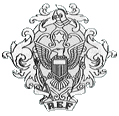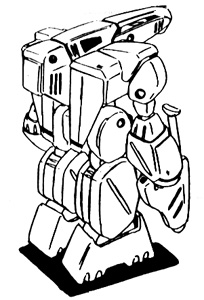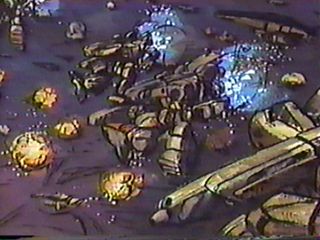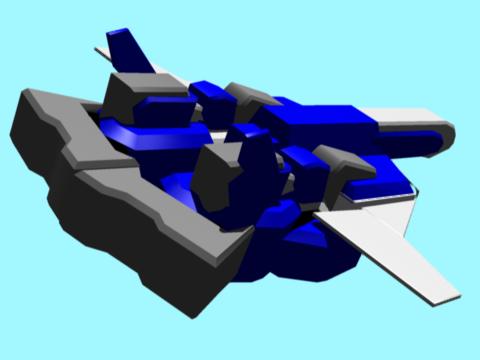 by Pieter Thomassen, with Peter Walker and Rob Morgenstern
by Pieter Thomassen, with Peter Walker and Rob Morgenstern
| | | | | |
VF-5 (A, B, C, T) Condor Veritech Fighter-Bomber
|

|
| |

|

| |
 |
 |  |  |  |  |  |
I. Dimensions:
| Fighter | VTOL | Battloid |
| Total Length: | 16.8m | 9.3m | - |
| Total Depth: | - | - | 6.3m |
| Total Height: | 4.1m | 7.9m | 12.8m |
| Total Breadth: | - | 6.3m | 6.3m |
| Total Wingspan: | 9.3m | - | - |
| Total dry weight: | 25.7 metric tons |
II. Type:
- (A, B, C): One/two man all-weather, aerospace combat mecha; two form Veritech with intermediate VTOL mode.
- (T): Two man all-weather, aerospace combat-capable trainer; two form Veritech with intermediate VTOL mode.
III. Service History:
- -5A: Served with the Expeditionary Forces Army, Navy and Marines from 2028 until 2032.
- -5B: Served with the Expeditionary Forces Army, Navy and Marines from 2031 until 2037.
- -5C: Served with the Expeditionary Forces Army, Navy and Marines from 2036 until 2040.
- -5T: Served with the Expeditionary Forces Army, Navy and Marines from 2031 until 2040.
IV. Propulsion:
- Engines
(VF-5A, -5B and -5T Models)
- 2 x Pratt & Whitney JG95A fusion plasma-air/reaction mass intermix turbines, one in each leg. Max thrust, 118 kN ea.
- 9 x Turbo-Union ATF 401 miniaturized fusion plasma-air/reaction mass intermix ramjets. Two are mounted on the upper rear (jet mode only), two are flanking the JG95 engine in each legs, and three are mounted as VTOL thrusters on the lower fuselage. Each engine is rated to 46.9 kN standard thrust, max overboost to 91.1 kN for short periods.
- 2 x Pratt & Whitney FE-98B first-stage intake fans, providing pressurized airflow to main, auxiliary, and VTOL engines.
- Assorted small reaction thrusters and gyroscopes for all-environment maneuvers, attitude adjustment, and stability.

- [Optional] Two external booster engine pods can be attached to the back, in VTOL mode only. The two PSE7C reaction engines in each pod are rated to 56 kN each, but can only be fired for 4 minutes before fuel burnout. Typically, these pods were employed when the mecha was used as an airdropped, heavy air-to-ground assault battloid.
(VF-5C Model)
- As the VF-5A, -B and -T models, but with the Pratt & Whitney JG-95M (max thrust, 137 kN ea.) replacing the JG-95A version.
- Powerplant: 2 x RRL-2P Miniaturized Protoculture-cell energizer
- Fuel Capacity:
- 32 Standard Canisters of Protoculture (excluding dedicated cannisters for energy weapons)
- 38.2 lit. D2O reactant for fusion engines.
V. Performance:
| |
Condor Fighter Mode GALLERY | (by Matt Willis) |

|
| |
|
|
|
A. Fighter mode (VF-5C):
- Max level speed at 18km: 2230 kph at 18km (Mach 2.1)
- Max level speed at sea level: 1000 kph at sea level (Mach .9)
- Stall speed : 237 kph (VTOL rectification possible)
- Initial climb rate: over 30000m per minute
- Service ceiling : 35 km
B. VTOL Mode:
- Max level speed : 220 kph
- Stall speed : None (VTOL)
C. Battloid Mode:
- Max running speed : 108 kph
- Max flying speed : 362 kph
- Service ceiling : 2440m
D. General:
- Combat radius (space): total delta-v 7.8 (VF-5A, -B and -T) or 8.2 kps (VF-5C), with internal reaction mass only. Two extra tanks for 2.8 kps (VF-5C, 3.0 kps) delta-v each can be attached externally and a bomb bay tank (4.1 kps (VF-5C, 4.2 kps)) can be carried internally.
- Protoculture supply : 220 hours operational use.
- Design G limits : +11.5/-6.0 (Computer overrides at +10.5g)
VI. Electronics:
Radar tracking:
- Hughes APG-111 X-band spherical pulse-Doppler, providing long-range detection and tracking of targets at all altitudes.
Optical tracking:
- Phillips AllView multi-band digital camera system, for medium range all attitude infra-red imaging, optical and ultra-violet band detection and tracking.
- Thomson LT-5 multi-frequency laser ranger and designator.
Tactical Electronic Warfare System (TEWS):
- Elettronica Radar Warning Receiver (RWR),
- OlDelft Infra-red Warning Receiver (IRWR),
- Westinghouse ALQ-250(V) active sensor jammer,
- Chaff dispenser,
- Flares.
VII. Armament:
Cannon:
- 1 x EP-12 three-barrelled 80mm particle gun pod, firing 240 rounds per minute. The barrels can be fired in sequence, or in one full power burst, with a rate of fire of 80 salvos per minute. This weapon fires 8.4 MJ pulses per barrel, and has its own dedicated protoculture cells and capacitor banks. The weapon is carried in the right arm of the mecha. A stripped down version of this weapon later saw service as the EP-13.
Missiles:
- 32 short range (8.2 km) Mach 3.0 combined infra-red imager and active radar homing 190mm x 540mm Hammerhead missiles. The missiles are mounted in containers on both sides of the lower legs; 8 to each container.
External ordnance:
- 2 Hardpoints per wing, with multiple ordnance options, and two hardpoints under the intakes. The wing missiles are only available in fighter mode, and the Condor cannot transform without first ejecting both payload and racks. Available payloads include, but are not limited to, the following:
- Medium range (65km) Mach 3.2 combined infra-red imager and active radar homing 260mm x 1.2m Diamondback missiles. Seven such missiles can be stored on an AMER (Articulating Multiple Ejection Rack) on each wing hardpoint. The intake hardpoints can mount a quintuple, horizontal rack. The total is up to thirty-eight missiles.
- or RMS-2 "Angel Of Death II" Nuclear stand-off missile. Reaction warhead (200 kT) mounted on a long range (293 km) Mach 4.0 combined multi-spectrum imager and active radar homing missile. Maximum delta-v in space is 5 kps. One may be carried under each hardpoint, for a total of up to six.
- or Firebird missile. A conventional warhead mounted on the frame of a RMS missile with a range of 234 km and a speed of Mach 6.5, guided by a combined IIR, and active/passive radar seeker. Maximum delta-v in space is 5 kps. One may be carried under each hardpoint, for a total of up to six.
- or CBM-200 cluster missiles (one per hardpoint). Two hundred guided cluster bombs with a range of 500 meters mounted on a long range (80 km) Mach 4.0 combined multi-spectrum imager and active radar homing missile. Customized for anti-mecha operations both in space and on the ground. Maximum delta-v in space is 3.5 kps.
Weapon bay:
- The weapon bay is fitted for:
- 4 x Derringer long range (70 km for A variant, 130 km for E/F variants), Mach 3.0 multi-spectrum imager and active radar homing missiles,
- or 16 x 250 kg laser-guided HE bombs,
- or 8 x 500 kg cluster bombs,
- or 4 x 1000 kg Armor Piercing self-guided glide bombs,
- or an additional reaction mass tank,
- or high power, long distance, multi-spectral reconnaissance pod.
Note: all data is for normal capacity; the mecha can carry a combination of payloads, and can be overloaded with extra weight, if the needed the ordnance can fit through the bomb bay doors. The weapon bay is certified for a total internal load of 4500kg, although heavier loads are possible at the expense on manouverability and acceleration.
VIII. Armor:
The armor on the Condor is a new development in low-mass composite-materials Chobham plating that became the standard for all Terran mecha after its application to the VQ-6A Vandal. Aside from the respectable protection provided against projectiles, missiles, and other kinetic weapons, this armor is also resistant to plasma globes (annihilation discs), lasers, and to a lesser extent, particle guns, owing to the fact that the armor can flake off and evaporate in layers under fire from such high-energy weapons, taking much of the weapon's energy and converting it into the latent heat of sublimation in the armor. The armor stops all small arms, heavy infantry weapons fire, and light mecha-mounted weaponry, and provides fair to good resistance to medium mecha-mounted weaponry, such as the Valkyrie's 55mm APFSDS round.
The Condor provides full protection from nuclear, biological, and chemical hazards, using a sealed cockpit environment activated by radiation and hazardous chemical sensors, or manually when biological warfare conditions are anticipated. The internal consumables supplies can provide atmosphere for three days maximum.
IX. Development:
The VF-5 Condor is a heavy complementing fighter-bomber to the VF-6 Alpha series of fighters. Its design is clearly based in identical roots as the Alpha, with the arms and legs having much the same transformation sequence as on the smaller design. However, the main body and cockpit sections clearly separate the VF-5 Condor from the other designs, and resemble those its' development rival, the VF-7 which later, in the shape of the VF-12 Beta, became its successor.
Some of these features were the protruding snout, which, unlike in the later Beta, did not retract during transformation. The bomb bay swivelled forward and formed the connection between the legs and the main body. The Condor was propelled by no less than eight horizontal, two large and six smaller ones. This gave the Condor excellent acceleration, although the maximum sustained atmospheric speed was limited due to arodynamic constraints. However, by using maximum thrust for a short period, the Condor was capable of reaching low orbit independently. In addition, there were three dedicated VTOL thrusters for use in fighter and VTOL mode. although resistant to battle damage, this complex propulsion setup cost many additional maintenance hours, and the successor design (VF-12 Beta)reverted to three larger horizontal engines rather than a larger number of smaller ones.
The Condor was tasked in the Expeditionary Forces with heavy assault on starships and ground installations with missiles or bombs. As such, the design fulfilled its expectations, being very well armored and packing a large punch. Apart from the payload as a bomber, in its bay and on its hardpoints, the Condor carried thirty-two defensive missiles on its legs, and on the right arm one of the heaviest beam cannons ever carried by human airborne mecha. This weapon alone could destroy any opposing enemy mecha with its penetrating salvo's.
In addition to the bomber taskings, this tough design also served as a heavy, airmobile, assault mecha in battloid mode, usually with a thruster pack attached to the rear. Typically, the Condor was in these cases transported to the battle in a cargo craft, then released while still airborne.
The VF-5 Condor was built in four different versions. The VF-5A was built only on Earth, and went with the Expeditionary Forces when they folded. The VF-5B had the same characteristics, but also many detail design changes to facilitate production of the mecha on board the Robotech Repair Factory. The VF-5C had upgraded main engines which improved speed in fighter mode slightly, and gave more delta-v in space due to more efficient fuel usage. This final model served until 2040, when it was replaced by the VF-12 Beta.
See additional design notes.
Return to REF Veritech Index.
Return to Robotech Reference Guide Home Page.
Robotech (R) is the property of Harmony Gold. This document is in no
way intended to infringe upon their rights.
Content by Pieter Thomassen, with Peter Walker and Rob Morgenstern
HTML by Robert Morgenstern (rmorgens@ieee.org)
Copyright © 2001 Robert Morgenstern, Pieter Thomassen, Peter Walker






